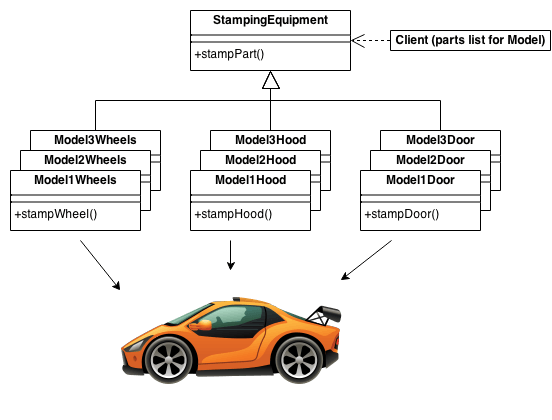Table Of Content

We then made calls to the addIngredients() and bakePizza() methods on the Pizza object before returning it to the caller. We use it when we need an interface for the creation of dependent objects without necessarily specifying their concrete classes. At the same time, we want to encapsulate the construction of “products” using inheritance. For each variant of a product family, we create a specific factory class based on the FurnitureFactory interface.
Concrete Factories
Buy the eBook Dive Into Design Patterns and get the access to archive with dozens of detailed examples that can be opened right in your IDE. Can you please explain more on Abstraction in case of Factory as well as Abstract Factory. I am not able to see the abstraction as the client still needs to know what to instantiate and what parameters to pass to instantiate the required class. This pattern is particularly useful when the client doesn’t know exactly what type to create. Define interfaces for cars and specifications to ensure a common structure.
See Artist Moholy-Nagy Illuminate The Future At This Magnificent Guggenheim Exhibit - Forbes
See Artist Moholy-Nagy Illuminate The Future At This Magnificent Guggenheim Exhibit.
Posted: Fri, 22 Jul 2016 07:00:00 GMT [source]
Families of cross-platform GUI components and their production
In the code above, since the AbstractFactory acts as a base class, the abstract methods are instantiated just as mentioned in the base class. You may be familiar with the concept factories - these are objects that create other objects. The Abstract Factory Pattern is primarily concerned with the interface for factory objects. The solution is to reduce the code that constructs components across the framework into a single factory method and let anyone override this method in addition to extending the component itself. A design pattern is a generic, reusable solution to a commonly encountered problem within a specific context in software design. It is not a finished design that can be transformed directly into code.
Software Design Pattern in Development

In the string conversion example, we demonstrated how the Factory Design Pattern allows us to switch between different conversion types easily. This pattern promotes modularity, extensibility, and code reusability, making it a valuable tool in software development. Secondly, this pattern minimizes the dependency between classes.

Step 6
The intriguing fact here is that, not always this is true especially when expected behavior cannot be modeled by a programming contract. The Abstract Factory design pattern producing families of related or dependent objects without specifying their concrete classes. All of this - according to many parameters that the UI is not aware of.All of this will be too much for a single factory class. This pattern is particularly useful when the client doesn't know exactly what type to create.
More reads:
But what pattern means a commonly used approach for a solution to a similar type of problems. A design pattern provides you a design level approach or solution to a set of similar type of design problem. Using design pattern help you solve your problem and hence deliver faster. The Abstract Factory Design Pattern is a creational pattern that provides a framework to create interfaces of closely related objects without specifying their classes - hence the term "abstract". Defining keywords is the secret recipe in this series of quick-guides. This method helped me truly understand the design patterns, hardcode them in my mind and comprehend the differences among other design patterns.
Object creations in this case is delegated to each implementer and framework providers just provide uniform methods for creating and returning objects. Such methods are inevitable for framework developer to proceed with their code and has a special name called Factory method (Factory Method Pattern for the underlying pattern). Abstract Factory serves as a high-level blueprint that defines a set of rules for creating families of related objects without specifying their concrete classes.
Design Patterns — A quick guide to Abstract Factory.
Abstract Products represents a family of related objects by defining a set of common methods or properties. It acts as an abstract or interface type that all concrete products within a family must adhere to and provides a unified way for concrete products to be used interchangeably. Concrete Factories implement the rules specified by the abstract factory. It contain the logic for creating specific instances of objects within a family. Also multiple concrete factories can exist, each tailored to produce a distinct family of related objects. Abstract Factory patterns work around a super-factory which creates other factories.
I work thinking and creating solutions through clean and readable code. Pentalog Connect is your free pass to a large community of top engineers who excel in developing outstanding and impactful digital products. When joining, you receive access to a wealth of resources that will feed your appetite for quality content and your need for professional growth. As software developers, we all want to write code that is easy to maintain, scalable, ... Hi, I just want to provide a constructive criticism about the example.
Pentalog is a digital services platform dedicated to helping companies access world-class software engineering and product talent. With a global workforce spanning 16 locations, our staffing solutions and digital services power client success. By joining Globant, Pentalog strengthens its offering with new innovation studios and an additional 51 Delivery Centers to assist companies in tackling tomorrow's digital challenges. If you can’t figure out the difference between various factory patterns and concepts, then read our Factory Comparison. Creating objects directly within the class that requires the objects is inflexible.
AccountFactory takes an AccountType as input and returns a specific BankAccount as output. There's nothing in the pattern that says an object can't belong to more than one family (although your use case might prohibit it). Each concrete factory is responsible for deciding which products are allowed to be created together. The Factory Method design pattern using subclasses to provide the implementation.
All variants of the same object must be moved to a single class hierarchy. You need a way to create individual furniture objects so that they match other objects of the same family. Customers get quite mad when they receive non-matching furniture. T.S.I collection is dedicated to fancy fabrics, whether it's silk or any other quality. This is a result of our extensive research, forecasting abilities, and our respect for the needs of our clients. We have always been committed to excellent customer service, superior quality and on time deliveries.



